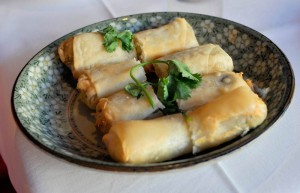American food culture affects Chinese cuisine
When I lived in Singapore, I was pampered by the cheap Chinese dishes with varying tastes and textures at food courts, the dim sum dishes from hawker stalls and the occasional multi-course Chinese banquet during special events.

Tasty rolls · Most Chinese-American dishes wouldn’t satisfy the tastes of Chinese gourmets, but are successful at enticing locals. - Sophia Lee | Daily Trojan
But in the United States, all I found was dishes that serve the same goopy, sweet and greasy sauce on chicken, pork or shrimp with a crescent-moon shaped cracker on the side. I realized quickly the Chinese food in America was a different cuisine in and of itself.
Like it or not, Chinese food has seeped into the American tradition. It’s a common joke that on Christmas Jewish families celebrate the day off by piling into their local version of Chinatown Express. In the Los Angeles Grand Central Market, an abundance of Latino customers sit around the booths at China Café and scoop generous amounts of chili oil into their chop suey noodles.
This culinary landscape is vastly different from the one in mid-19th-century America, when Chinese immigrants from Canton (now Guangdong province of China) first started settling in large groups in California.
From little carts by worksites, Chinese cuisine pushed through the forefront of America’s mainstream culinary scene to brick-and-mortar restaurants and fast food chains since the ’20s.
Chinese food became popular not just because the American palate got bolder, but because Chinese cuisine was open to adjustments. The most popular “Chinese” dishes on the menu — sweet and sour pork, beef broccoli or orange chicken — are all cheap and fast basic meat-and-vegetable dishes drenched in standard sauces that are easily adaptable or substitutable to fit the American palate.
Indeed, more so than the native cuisine, these ethnic-inspired dishes reveal more about American history and culture than they do about Chinese.
After World War II, perhaps because of the greater attention on East Asian countries brought home by war veterans or because of the growing middle class, Americans actively branched away from the usual Cantonese dishes to incorporate other regional cuisines such as Hunan, Szechuan and Fujien. Instead of just looking for a fast, affordable meal, Americans became more interested in the experience of these “exotic” new cuisines.
Now in Los Angeles, Chinese food is accessible in varying levels of authenticity. Discerning foodies might immediately taste the difference between an “authentic” Chinese restaurant and an Americanized version of the food, but the most obvious disparity is location.
Take-out Chinese-American eateries pervade every street, most likely with the words that clearly indicate Chinese (“panda” and “Hong Kong” for example). But those who seek a more authentic bite will need to travel out to cities in San Gabriel Valley like Monterey Park and Arcadia, where restaurants will be less ostensibly “Oriental.”
Interior design and service is another indicator — even before you taste the food, use your eyes. The popular Chinese-American chain P.F. Chang’s, for example, decks out its dining room with calligraphy and paintings of royal concubines, while Mama’s Lu at Monterey Park is low-key and modest in design.
As for the food, the most tangible way to distinguish an authentic dish from an unauthentic one is the sauce Americanized dishes are heavier, sweeter and richer on the sauce. The spice level is toned down; a kung pao dish at P.F. Chang’s keeps its chili peppers gently fried to keep their heat from permeating the rest of the ingredients, as opposed to the more traditional way of charring the chilies so that the spiciness breaks out of the capsicum shells.
To be fair, Chinese cuisine is incredibly diverse. China is a huge country with myriad regional cuisines, and its emmigrants take their dishes all over the world, transforming them according to local diets. In fact, many Chinese natives have not experienced dishes outside their respective familiar regions.
The majority of the “Chinese” restaurants in America might horrify a native Chinese gourmet, but they played an initial and integral role in diversifying the American culinary appetite and opening the doors to other Asian cuisines, such as Japanese and Vietnamese.
Nine years since I visited my first Chinese-American restaurant, I’ve learned to crave chicken in cornstarch-laden sauce after a long day. Once in a while, there is something nice and special about breaking apart a fortune cookie after some greasy chow mein with moo shu chicken.
Perhaps it’s a sign that I, too, have broadened my tastes to America.
Sophia Lee is a junior majoring in print and digital journalism and East Asian languages and cultures. Her column “Cross Bites” runs Mondays.

Great Article!!! Sophia. Love your writing.
not true, it IS to fit the american palate. it’s just like how taco bell/chipotlr is not authentic mexican either. and italian restaurants in the US NEVER does it al dente.
chinese cuisine is either really fresh (bland) really spicy or really weird (think whole fish/fish head, whole chicken, liver, etc).
but in general, it is difficult to completely replicate many of the chinese cuisine in the US. since different flour is used, and there is a lack of fresh seafood/poultry (it comes with a very high cost)
if the “running dogs” and “black devils” want more authentic chinese food, they should go to san grabriel valley. otherwise, it’s not feasible to NOT adapt to the american palate.
Fit the American palate? Maybe the ones bringing in the goods just gave em their cheapest ingredients since after all, what else do white “running dogs” and “black devils” deserve? Then most would never be the wiser, not having a chance to try the home cooking. So the title could be “How Cheapass Chinese Haters Shaped American-Chinese Cuisine”. I’m a running dog, btw.